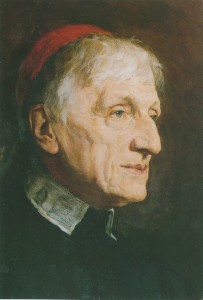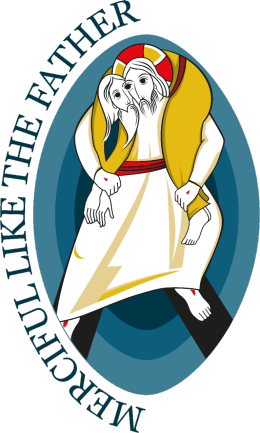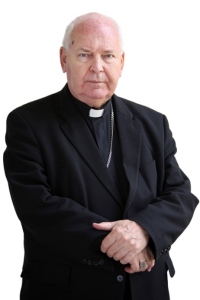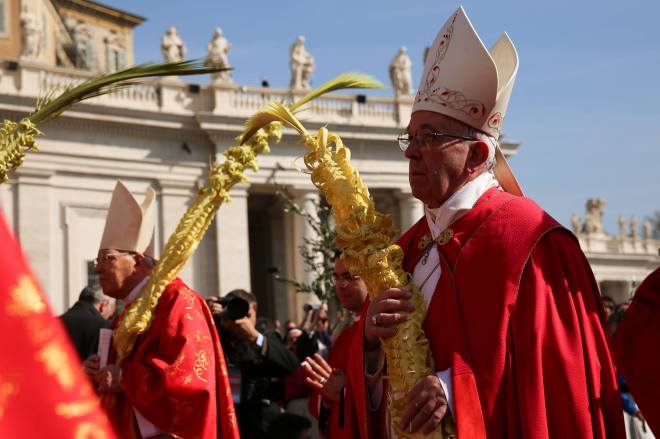
Blessed John Henry Newman is to be declared a saint. That joyful news was announced today as Pope Francis authorised the promulgation of a decree recognising, among other things, a second miracle attributed to the intercession of the English cardinal. That second miracle is required before a person can be canonised (unless he or she is recognised as a martyr).
In 2010, Cardinal Newman was beatified by Pope Benedict XVI during his papal visit to the United Kingdom. That visit was centred to a large extent around the person of the soon-to-be-saint, and Pope Benedict spoke about him on several occasions. Below I wish to share a few of the Pope emeritus’ thoughts, as a way to mark the great news. All the quotations were taken from the official texts available on the website of the Vatican, linked to above:
“As you know, Newman has long been an important influence in my own life and thought, as he has been for so many people beyond these isles. The drama of Newman’s life invites us to examine our lives, to see them against the vast horizon of God’s plan, and to grow in communion with the Church of every time and place: the Church of the apostles, the Church of the martyrs, the Church of the saints, the Church which Newman loved and to whose mission he devoted his entire life.”
“On the one hand Cardinal Newman was above all a modern man, who lived the whole problem of modernity; he faced the problem of agnosticism, the impossibility of knowing God, of believing. He was a man whose whole life was a journey, a journey in which he allowed himself to be transformed by truth in a search marked by great sincerity and great openness, so as to know better and to find and accept the path that leads to true life. This interior modernity, in his being and in his life, demonstrates the modernity of his faith. It is not a faith of formulas of past ages; it is a very personal faith, a faith lived, suffered and found in a long path of renewal and conversion. He was a man of great culture, who on the other hand shared in our sceptical culture of today, in the question whether we can know something for certain regarding the truth of man and his being, and how we can come to convergent probabilities. He was a man with a great culture and knowledge of the Fathers of the Church. He studied and renewed the interior genesis of faith and recognized its inner form and construction. He was a man of great spirituality, of humanity, of prayer, with a profound relationship with God, a personal relationship, and hence a deep relationship with the people of his time and ours. So I would point to these three elements: modernity in his life with the same doubts and problems of our lives today; his great culture, his knowledge of the treasures of human culture, openness to permanent search, to permanent renewal and, spirituality, spiritual life, life with God; these elements give to this man an exceptional stature for our time. That is why he is like a Doctor of the Church for us and for all, and also a bridge between Anglicans and Catholics.”
“At the end of his life, Newman would describe his life’s work as a struggle against the growing tendency to view religion as a purely private and subjective matter, a question of personal opinion. Here is the first lesson we can learn from his life: in our day, when an intellectual and moral relativism threatens to sap the very foundations of our society, Newman reminds us that, as men and women made in the image and likeness of God, we were created to know the truth, to find in that truth our ultimate freedom and the fulfilment of our deepest human aspirations. In a word, we are meant to know Christ, who is himself “the way, and the truth, and the life” (Jn 14:6).”
“Newman’s life also teaches us that passion for the truth, intellectual honesty and genuine conversion are costly. The truth that sets us free cannot be kept to ourselves; it calls for testimony, it begs to be heard, and in the end its convincing power comes from itself and not from the human eloquence or arguments in which it may be couched.”
“Finally, Newman teaches us that if we have accepted the truth of Christ and committed our lives to him, there can be no separation between what we believe and the way we live our lives. Our every thought, word and action must be directed to the glory of God and the spread of his Kingdom. Newman understood this, and was the great champion of the prophetic office of the Christian laity. He saw clearly that we do not so much accept the truth in a purely intellectual act as embrace it in a spiritual dynamic that penetrates to the core of our being. Truth is passed on not merely by formal teaching, important as that is, but also by the witness of lives lived in integrity, fidelity and holiness; those who live in and by the truth instinctively recognize what is false and, precisely as false, inimical to the beauty and goodness which accompany the splendour of truth, veritatis splendor.”
“Cardinal Newman’s motto, Cor ad cor loquitur, or “Heart speaks unto heart”, gives us an insight into his understanding of the Christian life as a call to holiness, experienced as the profound desire of the human heart to enter into intimate communion with the Heart of God. He reminds us that faithfulness to prayer gradually transforms us into the divine likeness. As he wrote in one of his many fine sermons, “a habit of prayer, the practice of turning to God and the unseen world in every season, in every place, in every emergency – prayer, I say, has what may be called a natural effect in spiritualizing and elevating the soul. A man is no longer what he was before; gradually … he has imbibed a new set of ideas, and become imbued with fresh principles” (Parochial and Plain Sermons, iv, 230-231). Today’s Gospel tells us that no one can be the servant of two masters (cf. Lk 16:13), and Blessed John Henry’s teaching on prayer explains how the faithful Christian is definitively taken into the service of the one true Master, who alone has a claim to our unconditional devotion (cf. Mt 23:10). Newman helps us to understand what this means for our daily lives: he tells us that our divine Master has assigned a specific task to each one of us, a “definite service”, committed uniquely to every single person: “I have my mission”, he wrote, “I am a link in a chain, a bond of connexion between persons. He has not created me for naught. I shall do good, I shall do his work; I shall be an angel of peace, a preacher of truth in my own place … if I do but keep his commandments and serve him in my calling” (Meditations and Devotions, 301-2).”
“While it is John Henry Newman’s intellectual legacy that has understandably received most attention in the vast literature devoted to his life and work, I prefer on this occasion to conclude with a brief reflection on his life as a priest, a pastor of souls. The warmth and humanity underlying his appreciation of the pastoral ministry is beautifully expressed in another of his famous sermons: “Had Angels been your priests, my brethren, they could not have condoled with you, sympathized with you, have had compassion on you, felt tenderly for you, and made allowances for you, as we can; they could not have been your patterns and guides, and have led you on from your old selves into a new life, as they can who come from the midst of you” (“Men, not Angels: the Priests of the Gospel”, Discourses to Mixed Congregations, 3). He lived out that profoundly human vision of priestly ministry in his devoted care for the people of Birmingham during the years that he spent at the Oratory he founded, visiting the sick and the poor, comforting the bereaved, caring for those in prison.”
John Henry Newman’s feast day is 9 October, the date in 1845 on which he converted to the Catholic faith. That will most probably not change upon his canonisation. The most significant change is that Saint John Henry Newman may now be venerated world wide. The veneration of Blesseds is limited to the dioceses or countries where they lived and worked. No date has as of yet been announced for the canonisation, although it will most likely take place in Rome.
 Archbishop Luis Ladaria Ferrer, soon to be a cardinal, took over the reins at the CDF after Cardinal Gerhard Müller was let go about a year ago. And since then, the Congregation published two major texts: Placuit Deo on Christian salvation, in February, and Oeconomicae et pecuniariae quaestiones on ethics in economy (published jointly with the Dicastery for Integral Human Development), in May. In comparison, that is the same number of documents released during the entire period that Cardinal Müller headed the CDF, from 2012 to 2017.
Archbishop Luis Ladaria Ferrer, soon to be a cardinal, took over the reins at the CDF after Cardinal Gerhard Müller was let go about a year ago. And since then, the Congregation published two major texts: Placuit Deo on Christian salvation, in February, and Oeconomicae et pecuniariae quaestiones on ethics in economy (published jointly with the Dicastery for Integral Human Development), in May. In comparison, that is the same number of documents released during the entire period that Cardinal Müller headed the CDF, from 2012 to 2017.

 “Today is the start of Advent, the period of preparation before Christmas. We celebrate that the Lord has come, but also that He is the one who is coming. We speak of a double, or even triple, coming. This thought is dear to me and nourishes my faith life.
“Today is the start of Advent, the period of preparation before Christmas. We celebrate that the Lord has come, but also that He is the one who is coming. We speak of a double, or even triple, coming. This thought is dear to me and nourishes my faith life.
 “At Christmas we celebrate that our God became visibly and tangibly among us in the Child of Bethlehem, our Lord Jesus Christ. Pope Francis has said about him, “Jesus Christ is the face of the Father’s mercy” (Misericordiae Vultus, 1). The Holy Father wrote these words when he announced the Holy Year of Mercy on 11 April 2015. This Holy Year began with the opening of the Holy Door in St. Peter’s Basilica in Rome, and subsequently with the opening of Holy Doors in all the world’s dioceses. In our Archdiocese of Utrecht, these were in Utrecht, Hengelo and Groenlo. The Holy Year is now ended, or perhaps we could say, whisked by. But we should be watchful that what the Holy Year of Mercy has brougth us, will not simply disappear. For this year has brought the Church – also in the Archdiocese of Utrecht – much that is good and encouraging.
“At Christmas we celebrate that our God became visibly and tangibly among us in the Child of Bethlehem, our Lord Jesus Christ. Pope Francis has said about him, “Jesus Christ is the face of the Father’s mercy” (Misericordiae Vultus, 1). The Holy Father wrote these words when he announced the Holy Year of Mercy on 11 April 2015. This Holy Year began with the opening of the Holy Door in St. Peter’s Basilica in Rome, and subsequently with the opening of Holy Doors in all the world’s dioceses. In our Archdiocese of Utrecht, these were in Utrecht, Hengelo and Groenlo. The Holy Year is now ended, or perhaps we could say, whisked by. But we should be watchful that what the Holy Year of Mercy has brougth us, will not simply disappear. For this year has brought the Church – also in the Archdiocese of Utrecht – much that is good and encouraging. As bishops of the Archdiocese of Utrecht we are very grateful to the Pope for the past Holy Year of Mercy. Much has been received and shared in our parishes and establishments, in faith, hope and love. Much work has been done to make the Holy Year a reality in the liturgy, catechesis and charity. Both the spiritual and corporal works of mercy have been frequently highlighted and put into practice. People – young and old(er) – have received the sacrament of God’s mercy – the sacrament of Penance and Reconciliation, or Confession – and that is a source of great grace and joy.
As bishops of the Archdiocese of Utrecht we are very grateful to the Pope for the past Holy Year of Mercy. Much has been received and shared in our parishes and establishments, in faith, hope and love. Much work has been done to make the Holy Year a reality in the liturgy, catechesis and charity. Both the spiritual and corporal works of mercy have been frequently highlighted and put into practice. People – young and old(er) – have received the sacrament of God’s mercy – the sacrament of Penance and Reconciliation, or Confession – and that is a source of great grace and joy. We are very grateful to our priests, deacons, religions, pastoral workers, coworkers, catechsists and all our volunteers for all the good and blessed work they have done for the success of the Holy Year of Mercy!
We are very grateful to our priests, deacons, religions, pastoral workers, coworkers, catechsists and all our volunteers for all the good and blessed work they have done for the success of the Holy Year of Mercy! In the Eucharistic celebration on the Dutch day, Cardinal Eijk said, for that reason, that the logo of the Holy Year of Mercy, the logo that was especially designed in Rome for this Hole Year, should remain etched in our minds. After all, it is a striking logo that highlights so clearly that mercy is a key word for the Christian faith. This logo depicts Jesus carrying a man on his back. It is based on the parable told by Jesus in the fifteenth chapter of the Gospel according to Luke (15:1-10). This parable speaks of the shepherd with a hundred sheep of which one gets lost. The shepherd leaves the 99 in the wilderness to search for that one lost sheep.
In the Eucharistic celebration on the Dutch day, Cardinal Eijk said, for that reason, that the logo of the Holy Year of Mercy, the logo that was especially designed in Rome for this Hole Year, should remain etched in our minds. After all, it is a striking logo that highlights so clearly that mercy is a key word for the Christian faith. This logo depicts Jesus carrying a man on his back. It is based on the parable told by Jesus in the fifteenth chapter of the Gospel according to Luke (15:1-10). This parable speaks of the shepherd with a hundred sheep of which one gets lost. The shepherd leaves the 99 in the wilderness to search for that one lost sheep. “Brothers and sisters,
“Brothers and sisters,
 The image of the divine mercy was created following the direction of Sister Faustina (1905-1938). In this image Jesus points at His heart, He looks at us and you a read and a white beam. It is an image of Jesus who gave His life out of boundless love for us. In the Gospels we can read in the passages about his passion and death on the cross about a soldier who stabbed his side with a spear, causing blood and water to flow (John 19:34). In the image of the divine mercy Jesus looks at us and He points at His heart. He shows that He wants to give everything for us, even His blood. He saves us. And the water reminds us of Baptism.
The image of the divine mercy was created following the direction of Sister Faustina (1905-1938). In this image Jesus points at His heart, He looks at us and you a read and a white beam. It is an image of Jesus who gave His life out of boundless love for us. In the Gospels we can read in the passages about his passion and death on the cross about a soldier who stabbed his side with a spear, causing blood and water to flow (John 19:34). In the image of the divine mercy Jesus looks at us and He points at His heart. He shows that He wants to give everything for us, even His blood. He saves us. And the water reminds us of Baptism. Sister Faustina, who only lived to the age of 33, wanted to share the message of God’s mercy. She said: this is so important, I cannot remain silent about this, I will tell this. She only went to school for three years, but she took up the pen and wrote. In the texts, Jesus calls her “His secretary of mercy’. She was an instrument of mercy. In order to make the limitless mercy of the Father known even more – for in he 1930s, like now, there was much crisis, threat of war, violence, discrimination and hate. Especially in a world of sin and evil God’s mercy must be announced. Sister Faustina wanted to do that, she wanted to be an instrument of mercy, a secretary of mercy.
Sister Faustina, who only lived to the age of 33, wanted to share the message of God’s mercy. She said: this is so important, I cannot remain silent about this, I will tell this. She only went to school for three years, but she took up the pen and wrote. In the texts, Jesus calls her “His secretary of mercy’. She was an instrument of mercy. In order to make the limitless mercy of the Father known even more – for in he 1930s, like now, there was much crisis, threat of war, violence, discrimination and hate. Especially in a world of sin and evil God’s mercy must be announced. Sister Faustina wanted to do that, she wanted to be an instrument of mercy, a secretary of mercy.
 “Brothers and sisters in Christ, today we mark the sixtieth year of the existence of the Diocese of Rotterdam. “Sixty years, is that worth celebrating?”, some initially wondered. “We celebrated fifty years in a major way. One hundred years would be something.”
“Brothers and sisters in Christ, today we mark the sixtieth year of the existence of the Diocese of Rotterdam. “Sixty years, is that worth celebrating?”, some initially wondered. “We celebrated fifty years in a major way. One hundred years would be something.”